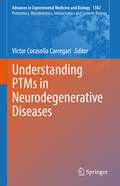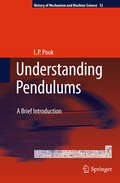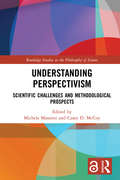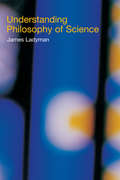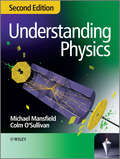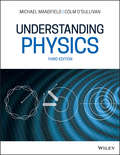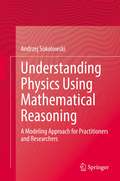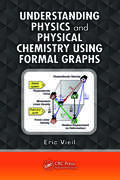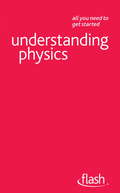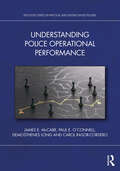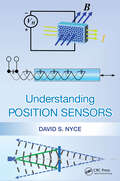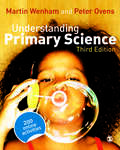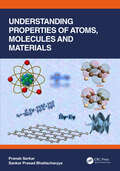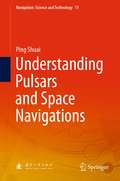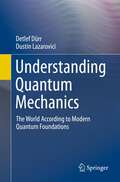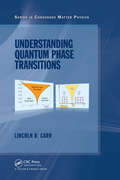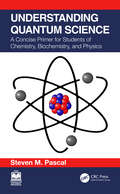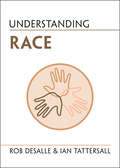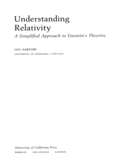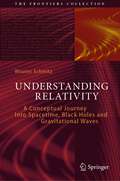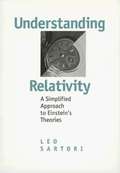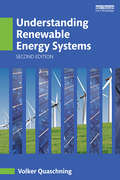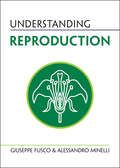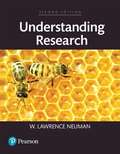- Table View
- List View
Understanding PTMs in Neurodegenerative Diseases (Advances in Experimental Medicine and Biology #1382)
by Victor Corasolla CarregariThis new volume, a part of the Proteomics, Metabolomics, Interactomics and Systems Biology series, will explain how proteomic studies of post-translational modifications (PTMs) can be applied to neurodegenerative diseases and relevant studies. The goal of the book is to increase awareness among researchers about how PTMs may be helpful in understanding mechanisms in various neurodegenerative diseases through proteomic studies. This book will serve as a tool for those who want to begin work in the proteomics field and explore how to implement PTMs studies into their work. Chapter authors will describe different PTMs enrichment methods developed by experts in the field so that researchers may learn to apply these methods and techniques to new studies. Divided into three sections, chapters will cover sample preparation, data quality, enrichment techniques, guidelines on how to analyze PTMs, and explain the role of PTMs and different brain diseases. Among those topics includes will be brain cancer, SLA disease, Parkinsons disease, muscular dystrophies, and schizophrenia. This volume will be useful for researchers and students studying brain and neurodegenerative diseases who are interested in delving into work with proteomic studies and PTMs.
Understanding Pendulums
by L. P. PookDespite their apparent simplicity, the behaviour of pendulums can be remarkably complicated. Historically, pendulums for specific purposes have been developed using a combination of simplified theory and trial and error. There do not appear to be any introductory books on pendulums, written at an intermediate level, and covering a wide range of topics. This book aims to fill the gap. It is written for readers with some background in elementary geometry, algebra, trigonometry and calculus. Historical information, where available and useful for the understanding of various types of pendulum and their applications, is included. Perhaps the best known use of pendulums is as the basis of clocks in which a pendulum controls the rate at which the clock runs. Interest in theoretical and practical aspects of pendulums, as applied to clocks, goes back more than four centuries. The concept of simple pendulums, which are idealised versions of real pendulums is introduced. The application of pendulums to clocks is described, with detailed discussion of the effect of inevitable differences between real pendulums and simple pendulums. In a clock, the objective is to ensure that the pendulum controls the timekeeping. However, pendulums are sometimes driven, and how this affects their behaviour is described. Pendulums are sometimes used for occult purposes. It is possible to explain some apparently occult results by using modern pendulum theory. For example, why a ring suspended inside a wine glass, by a thread from a finger, eventually strikes the glass. Pendulums have a wide range of uses in scientific instruments, engineering, and entertainment. Some examples are given as case studies.
Understanding Perspectivism: Scientific Challenges and Methodological Prospects (Routledge Studies in the Philosophy of Science)
by Michela Massimi Casey D. McCoyThis edited collection is the first of its kind to explore the view called perspectivism in philosophy of science. The book brings together an array of essays that reflect on the methodological promises and scientific challenges of perspectivism in a variety of fields such as physics, biology, cognitive neuroscience, and cancer research, just as a few examples. What are the advantages of using a plurality of perspectives in a given scientific field and for interdisciplinary research? Can different perspectives be integrated? What is the relation between perspectivism, pluralism, and pragmatism? These ten new essays by top scholars in the field offer a polyphonic journey towards understanding the view called ‘perspectivism’ and its relevance to science.
Understanding Philosophy of Science
by James LadymanFew can imagine a world without telephones or televisions; many depend on computers and the Internet as part of daily life. Without scientific theory, these developments would not have been possible.In this exceptionally clear and engaging introduction to philosophy of science, James Ladyman explores the philosophical questions that arise when we reflect on the nature of the scientific method and the knowledge it produces. He discusses whether fundamental philosophical questions about knowledge and reality might be answered by science, and considers in detail the debate between realists and antirealists about the extent of scientific knowledge. Along the way, central topics in philosophy of science, such as the demarcation of science from non-science, induction, confirmation and falsification, the relationship between theory and observation and relativism are all addressed. Important and complex current debates over underdetermination, inference to the best explaination and the implications of radical theory change are clarified and clearly explained for those new to the subject.
Understanding Physics
by Colm O'Sullivan Michael MansfieldUnderstanding Physics - Second edition is a comprehensive, yet compact, introductory physics textbook aimed at physics undergraduates and also at engineers and other scientists taking a general physics course. Written with today's students in mind, this text covers the core material required by an introductory course in a clear and refreshing way. A second colour is used throughout to enhance learning and understanding. Each topic is introduced from first principles so that the text is suitable for students without a prior background in physics. At the same time the book is designed to enable students to proceed easily to subsequent courses in physics and may be used to support such courses.Mathematical methods (in particular, calculus and vector analysis) are introduced within the text as the need arises and are presented in the context of the physical problems which they are used to analyse. Particular aims of the book are to demonstrate to students that the easiest, most concise and least ambiguous way to express and describe phenomena in physics is by using the language of mathematics and that, at this level, the total amount of mathematics required is neither large nor particularly demanding.'Modern physics' topics (relativity and quantum mechanics) are introduced at an earlier stage than is usually found in introductory textbooks and are integrated with the more 'classical' material from which they have evolved. This book encourages students to develop an intuition for relativistic and quantum concepts at as early a stage as is practicable.The text takes a reflective approach towards the scientific method at all stages and, in keeping with the title of the text, emphasis is placed on understanding of, and insight into, the material presented.
Understanding Physics
by Colm O'Sullivan Michael M. MansfieldAn updated and thoroughly revised third edition of the foundational text offering an introduction to physics with a comprehensive interactive website The revised and updated third edition of Understanding Physics presents a comprehensive introduction to college-level physics. Written with today's students in mind, this compact text covers the core material required within an introductory course in a clear and engaging way. The authors – noted experts on the topic – offer an understanding of the physical universe and present the mathematical tools used in physics. The book covers all the material required in an introductory physics course. Each topic is introduced from first principles so that the text is suitable for students without a prior background in physics. At the same time the book is designed to enable students to proceed easily to subsequent courses in physics and may be used to support such courses. Relativity and quantum mechanics are introduced at an earlier stage than is usually found in introductory textbooks and are integrated with the more 'classical' material from which they have evolved. Worked examples and links to problems, designed to be both illustrative and challenging, are included throughout. The links to over 600 problems and their solutions, as well as links to more advanced sections, interactive problems, simulations and videos may be made by typing in the URL’s which are noted throughout the text or by scanning the micro QR codes given alongside the URL’s, see: http://up.ucc.ieThis new edition of this essential text: Offers an introduction to the principles for each topic presented Presents a comprehensive yet concise introduction to physics covering a wide range of material Features a revised treatment of electromagnetism, specifically the more detailed treatment of electric and magnetic materials Puts emphasis on the relationship between microscopic and macroscopic perspectives Is structured as a foundation course for undergraduate students in physics, materials science and engineering Has been rewritten to conform with the revised definitions of SI base units which came into force in May 2019 Written for first year physics students, the revised and updated third edition of Understanding Physics offers a foundation text and interactive website for undergraduate students in physics, materials science and engineering.
Understanding Physics Using Mathematical Reasoning: A Modeling Approach for Practitioners and Researchers
by Andrzej SokolowskiThis book speaks about physics discoveries that intertwine mathematical reasoning, modeling, and scientific inquiry. It offers ways of bringing together the structural domain of mathematics and the content of physics in one coherent inquiry. Teaching and learning physics is challenging because students lack the skills to merge these learning paradigms. The purpose of this book is not only to improve access to the understanding of natural phenomena but also to inspire new ways of delivering and understanding the complex concepts of physics. To sustain physics education in college classrooms, authentic training that would help develop high school students’ skills of transcending function modeling techniques to reason scientifically is needed and this book aspires to offer such trainingThe book draws on current research in developing students’ mathematical reasoning. It identifies areas for advancements and proposes a conceptual framework that is tested in several case studies designed using that framework. Modeling Newton’s laws using limited case analysis, Modeling projectile motion using parametric equations and Enabling covariational reasoning in Einstein formula for the photoelectric effect represent some of these case studies. A wealth of conclusions that accompany these case studies, drawn from the realities of classroom teaching, is to help physics teachers and researchers adopt these ideas in practice.
Understanding Physics and Physical Chemistry Using Formal Graphs
by Eric VieilThe subject of this book is truly original. By encoding of algebraic equations into graphs-originally a purely pedagogical technique-the exploration of physics and physical chemistry reveals common pictures through all disciplines. The hidden structure of the scientific formalism that appears is a source of astonishment and provides efficient simpl
Understanding Physics: Flash (Ty Science Ser.)
by Jim BreithauptThe books in this bite-sized new series contain no complicated techniques or tricky materials, making them ideal for the busy, the time-pressured or the merely curious. Understanding Physics is a short, simple and to-the-point guide. In just 96 pages, the reader will learn all the basics, from atoms and molecules to forces, energy and quantum theory. Ideal for the busy, the time-pressured or the merely curious, Understanding Physics is a quick, no-effort way to break into this fascinating topic.
Understanding Police Operational Performance (Routledge Series on Practical and Evidence-Based Policing)
by James E. McCabe Paul E. O'Connell Demosthenes Long Carol Rasor-CorderoUnderstanding Police Operational Performance provides a roadmap for police agencies to implement performance-improvement strategies that work. This book provides an easy-to-read, comprehensive overview of the key indicators of successful internal operations of police agencies in the United States, and equips readers with the tools needed to bring police organizations to top performance. Ideal for law enforcement professionals, as well as city or county administrators and policymakers, this book offers practical advice for planning and conducting an evaluation of the various components of a police organization. It is also appropriate for use in law enforcement, criminal justice, and political science courses.
Understanding Position Sensors
by David NyceAs the definitive resource on position sensing technology, Understanding Position Sensors encompasses all aspects necessary for a full understanding of the field, with topics of background, operational theory, design, and application. While grasping the theory of technologies used in the measurement of linear and angular/rotary position sensors, the reader will also learn about terminology, interfacing, testing, and other valuable concepts that are useful in the understanding of sensors in general. The first three chapters provide readers with the necessary background information on sensors. These chapters review the working definitions and conventions used in sensing technology; specification of position sensors and the effect on performance; and sensor output types, plus an extensive section covering communication protocols. The remaining chapters describe each separate sensor technology in detail. These include resistive sensors, cable extension transducers, capacitive sensors, inductive sensors, LVDT and RVDT sensors, distributed impedance sensors, Hall effect sensors, magnetoresistive sensors, magnetostrictive sensors, linear and rotary encoders, optical triangulation position sensors, and ultrasonic position sensors. Presents sensor specification, theory of operation, sensor design, and application criteria Reviews the background history of position sensors as well as the underlying engineering techniques Includes end-of-chapter exercises Understanding Position Sensors is written for electrical, mechanical, and material engineers, as well as for engineering students who are interested in understanding sensor technologies, and can be used as a textbook for an engineering course on sensor technology.
Understanding Primary Science (Routledge Revivals Ser.)
by Matin Wenham Peter OvensNow in its third edition, this text provides the background knowledge primary teachers need to plan effective programmes of work and answer children's questions with confidence. The new edition links explanations of scientific concepts with children's everyday experiences to help teachers and trainees foresee how they will present the subject knowledge to their pupils. Shaped by the National Curriculum, this text explains key scientific theories and concepts which pupils at primary level, including very able children, need in order to understand the observations and investigations they undertake. A CD Rom of 200 science investigations for young students is included with the new edition, allowing teachers to explore the practical application of topics covered in the book. This is an essential book for teachers, student teachers and anyone interested in the roots and growth of science education.
Understanding Properties of Atoms, Molecules and Materials
by Sankar Prasad Bhattacharyya Pranab SarkarIn a technology driven civilization the quest for new and smarter materials is everlasting. They are required as platforms for developing new technologies or for improving an already existing technology. The discovery of a new material is no longer chance driven or accidental, but is based on careful reasoning structured by deep understanding of the microconstituents of materials - the atoms and molecules in isolation or in an assembly. That requires fair amount of exposure to quantum and statistical mechanics. `Understanding Properties of Atoms, Molecules and Materials' is an effort (perhaps the first ever) to bring all the necessary theoretical ingredients and relevant physical information in a single volume. The book introduces the readers (first year graduates) or researchers in material chemistry/engineering to elementary quantum mechanics of atoms, molecules and solids and then goes on to make them acquainted with methods of statistical mechanics (classical as well as quantum) along with elementary principles of classical MD simulation. The basic concepts are introduced with clarity and illustrated with easy to grasp examples, thus preparing the readers for an exploration through the world of materials - the exotic and the mundane. The emphasis has been on the phenomena and what shapes them at the fundamental level. A comprehensive description of modern designing principles for materials with examples is a unique feature of the book. The highlights of the book are comprehensive introduction and analysis of Quantum states of atoms and molecules The translational symmetry and quantum states in periodic and amorphous solids Band structure and tuning Classical and quantum statistics with applications to ideal gases (photons, phonons and electrons, molecules) Quantum states in type-I and type-II superconductors (elementary theory included) Magnetic materials, materials with GMR and CMR Shape memory effects in alloys and materials 2D materials (graphene and graphene analogus) NLO and photovoltaic materials Hydrogen storage material for mitigating the looming energy crisis Quantum states in low and high band gap semiconductors Semimetals Designer materials, etc. The volume is designed and organized to create interest in the science of materials and the silent revolution that is redefining the goals and boundaries of materials science continuously.
Understanding Pulsars and Space Navigations (Navigation: Science and Technology #11)
by Ping ShuaiThis book systematically presents the concept, history, implementation, theory system and basic methods of pulsar and space flight, illustrating the characteristics of pulsars. It also describes the classification of spacecraft navigation systems and the autonomous navigation technologies, as well as X-ray pulsar-based navigation systems (XPNAV) and discusses future navigation satellite systems in detail.
Understanding Quantum Mechanics: The World According to Modern Quantum Foundations
by Detlef Dürr Dustin LazaroviciThis book discusses the physical and mathematical foundations of modern quantum mechanics and three realistic quantum theories that John Stuart Bell called "theories without observers" because they do not merely speak about measurements but develop an objective picture of the physical world. These are Bohmian mechanics, the GRW collapse theory, and the Many Worlds theory. The book is ideal to accompany or supplement a lecture course on quantum mechanics, but also suited for self-study, particularly for those who have completed such a course but are left puzzled by the question: "What does the mathematical formalism, which I have so laboriously learned and applied, actually tell us about nature?”
Understanding Quantum Phase Transitions (Condensed Matter Physics)
by Lincoln D. CarrQuantum phase transitions (QPTs) offer wonderful examples of the radical macroscopic effects inherent in quantum physics: phase changes between different forms of matter driven by quantum rather than thermal fluctuations, typically at very low temperatures. QPTs provide new insight into outstanding problems such as high-temperature superconductivit
Understanding Quantum Science: A Concise Primer for Students of Chemistry, Biochemistry and Physics
by Steven M. PascalStudents are naturally drawn to quantum science by the intriguing behaviors of small particles. However, they can also be intimidated by the lengthy and complicated treatment found in the classroom. Understanding Quantum Science: A Concise Primer for Students of Chemistry, Biochemistry, and Physics is a highly accessible book that offers students an opportunity to grasp the most fascinating of quantum topics, without the intimidation. To be sure, math is necessary, but it is introduced as needed and kept concise. The emphasis is on the science: a certain differential equation can be solved, and when it is, we find the energies that hydrogen atom electrons are allowed to have. Each concept is developed in this manner, keeping focus on how and why it arises, and on the intriguing consequences.This book provides a brief tour of some of the wonders of quantum science. But it is more than that, it is designed to be the most concise tour possible that truly explains how these wonders arise so that you can develop a working understanding of quantum concepts. If your goal is loftier and you wish to become a quantum specialist, the conceptual groundwork presented here, along with rationalization of the mathematics required, will position you well for higher level classes.
Understanding Race (Understanding Life)
by Ian Tattersall Rob DeSalleThe human species is very young, but in a short time it has acquired some striking, if biologically superficial, variations across the planet. As this book shows, however, none of those biological variations can be understood in terms of discrete races, which do not actually exist as definable entities. Starting with a consideration of evolution and the mechanisms of diversification in nature, this book moves to an examination of attitudes to human variation throughout history, showing that it was only with the advent of slavery that considerations of human variation became politicized. It then embarks on a consideration of how racial classifications have been applied to genomic studies, demonstrating how individualized genomics is a much more effective approach to clinical treatments. It also shows how racial stratification does nothing to help us understand the phenomenon of human variation, at either the genomic or physical levels.
Understanding Relativity
by Leo SartoriNonspecialists with no prior knowledge of physics and only reasonable proficiency with algebra can now understand Einstein's special theory of relativity. Effectively diagrammed and with an emphasis on logical structure, Leo Sartori's rigorous but simple presentation will guide interested readers through concepts of relative time and relative space. Sartori covers general relativity and cosmology, but focuses on Einstein's theory. He tracks its history and implications. He explores illuminating paradoxes, including the famous twin paradox, the "pole-in-the-barn" paradox, and the Loedel diagram, which is an accessible, graphic approach to relativity. Students of the history and philosophy of science will welcome this concise introduction to the central concept of modern physics.
Understanding Relativity: A Conceptual Journey Into Spacetime, Black Holes and Gravitational Waves (The Frontiers Collection)
by Wouter SchmitzThis book bridges the huge gap between popular science and mathematical treatments of Einstein's theories. It explains special and general relativity, gravity, black holes, and gravitational waves, also presenting current ideas about dark matter and dark energy. The explanations are entirely non-mathematical, using many color pictures and clear concepts. In this way, the reader is led to a much deeper understanding than any popular science book can provide. The author has written this book for everyone who wants to go beyond superficial descriptions of relativity's remarkable phenomena, but is not equipped to read the professional literature and complicated math behind the theory. By providing a complete description in terms of concepts and pictures, the book answers many questions about why the theory works as it does. For example, it explains why and how momentum and pressure are related to gravity; why and how mass causes spacetime to curve and how curvature tells objects how to move; it also reveals the origin of the ring seen around the first ever image of a black hole. Not least, the reader will learn in detail how gravitational waves are produced and measured. Since their conception, the theories of relativity have appealed to the public's imagination. Thanks to this book, readers now have the opportunity to convert their fascination with the topic to a deep understanding.
Understanding Relativity: A Simplified Approach to Einstein's Theories
by Leo SartoriNonspecialists with no prior knowledge of physics and only reasonable proficiency with algebra can now understand Einstein's special theory of relativity. Effectively diagrammed and with an emphasis on logical structure, Leo Sartori's rigorous but simple presentation will guide interested readers through concepts of relative time and relative space. Sartori covers general relativity and cosmology, but focuses on Einstein's theory. He tracks its history and implications. He explores illuminating paradoxes, including the famous twin paradox, the "pole-in-the-barn" paradox, and the Loedel diagram, which is an accessible, graphic approach to relativity. Students of the history and philosophy of science will welcome this concise introduction to the central concept of modern physics.
Understanding Renewable Energy Systems
by Volker QuaschningBy mid-century, renewable energy must cover all of our energy supply if we are to phase out nuclear and successfully stop climate change. Now updated and expanded, the 2nd edition of this textbook covers the full range of renewable energy systems and now also includes such current trends as solar power storage, power-to-gas technologies, and the technology paths needed for a successful and complete energy transition. The topics are treated in a holistic manner, bringing together maths, engineering, climate studies and economics, and enabling readers to gain a broad understanding of renewable energy technologies and their potential.Numerous examples are provided for calculations, and graphics help visualize the various technologies and mathematical methodologies. Understanding Renewable Energy Systems is an ideal companion for students of renewable energy at universities or technical colleges on courses such as renewable energy, electrical engineering, engineering technology, physics, process engineering, building engineering, environment, applied mechanics and mechanical engineering, as well as scientists and engineers in research and industry.
Understanding Reproduction (Understanding Life)
by Alessandro Minelli Giuseppe FuscoOur understanding of reproduction and reproductive processes is often biased towards the behaviour of organisms most familiar to us. As such, the amazing disparity of the phenomena of reproduction and sex is often overlooked. Understanding Reproduction addresses all the main facets of this large chapter of the life sciences, including discussions of asexual reproduction, parthenogenesis, sex determination, reproductive effort, and much more. The book features an abundance of examples from across the tree of life, including animals, plants, fungi, protists and bacteria. Written in an accessible and easy to digest style, overcoming the intimidating diversity of the technical terminology, this book will appeal to interested general readers, biologists, science educators, philosophers and medical doctors.
Understanding Research (Second Edition)
by W. Lawrence NeumanUnderstanding Research is an introduction to research. W. Lawrence Neuman shows students that the subject is both interesting and highly relevant to their lives and professional work. The Second Edition makes the essentials of doing high-quality research accessible, in ways that create excitement about the research process. Core principles, processes, and procedures of research are distilled – and presented with salient real-world examples and the latest academic studies – in a manner that students will want to learn them. For courses in Experimental Methods and in Research Methods for Political Science and Sociology.
Understanding Research Methods: An Overview of the Essentials (7th edition)
by Mildred L. PattenTopics include Intro to Research Methods, Reviewing Literature, Sampling, Instrumentation, Experimental Design, Understanding Statistics, Effect Size and Meta-Analysis, Qualitative Research, and Preparing Research Reports.
